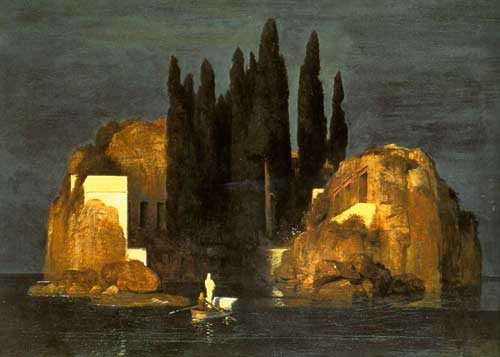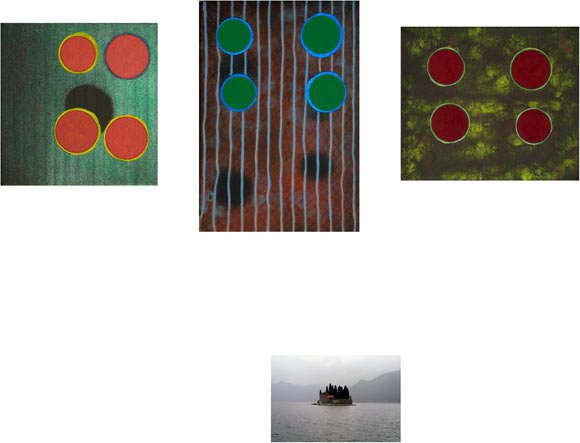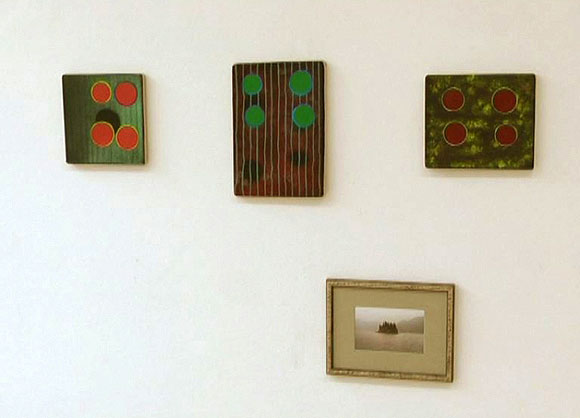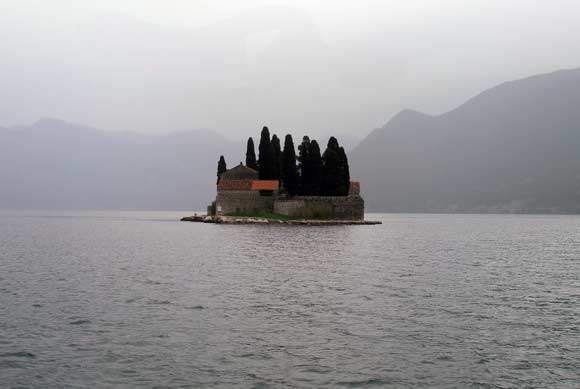sitemap
drawings
paintings
installations
projects
reviews

Arnold Böcklin; Die Toteninsel (1880)
Milan Golob; Die Toteninsel, 2011 (installation combining paintings and photography)
Installation Die Toteninsel consists of paintings Johann Mallovič (1819-1883), Arnold Böcklin (1827-1901), Ivan Marković (1850-1920) and photography of island Sveti Đorđe (Island of Saint George) in Boka Kotorska (Montenegro). For a decade the author has painted colourful structured paintings of small formats with four circles dominating various compositions. Nevertheless, as evident also from the current installation, the size of every painting is different, not a single circle is the same as another nor is any colour combinations repeated in other artworks. Every image has its own name and life that it lives autonomously or in an interaction with other paintings and photographs. The titles of Milan's artworks are inspired by real persons, more or less known individuals from the world of physics, literature, art …, as in the case of his first painting installation My Friends (paintings) and Natalija (drawings), 2006, or by the actual, although anonymous deceased, whom he introduced in the exhibition Queens of the Night, 2009, where the paintings were exhibited together with the photographs of tombstones featuring the name – title of the painting. Visiting cemeteries and gathering names of the deceased while taking photographs of tombstones is part of the artistic process. Milan creates his paintings with dedication and tenderness, and only chooses their titles subsequently, irrationally and relying on intuition, from the range of historical personalities or collection of his favourite people whom he mostly did not know personally. The story of the installation presented here is built on real individuals used by the author as the starting point of his narrative local legends and random associations. Around 1879 Arnold Böcklin and a certain countess allegedly visited Perast. Nearby is the island of Sveti Đorđe, where the town cemetery was located until 1866. The small island apparently inspired Böcklin (although the official sources claim otherwise) with his best known motif Die Toteninsel (The island of the dead), which was repeated in five variations (1880-86). The central painting of Milan's installation has thus been named after the symbolist. The two paintings on the left and right side were named after the deceased who lived in the town at the time of the painter's visit and most probably, speculates Milan, heard that the painter was in the town. Joahann Mallovič could have belonged to the Austro-Hungarian navy that was in the port at the time, and was depicted by a structure of gradual transition from dark to light pale turquoise green which serves as a backdrop to the bright English- red circles. Ivan Marković was perhaps a sea pirate, and is therefore depicted with the light Caput Mortuum circles on the background of the army–pirate green texture, intended to create mimicry. Under the three paintings there is a photography Sveti Đorđe, of the island which again united the dead and enchanted Milan Golob, who through the language of abstract painting and photography of a real location tells a story of potential reality and translates it into the actual reality of his own art context.
Meta Kordiš, curator in UGM / Maribor Art Gallery
Translation: Petra Shirley

Milan Golob; Die Toteninsel, 2011
........ From left to right:
............ Johann Mallovič (1819-1883), oil on canvas, 2011, 19 × 18 cm
............ Arnold Böcklin (1827-1901), oil on canvas, 2010, 27 × 19 cm
............ Ivan Marković (1850-1920), oil on canvas, 2010, 18 × 21 cm
............ Island of Saint George, digital photography, ink jet print, 2010, 10,2 × 15,2 cm

Milan Golob; Die Toteninsel, 2011 (Installation view - Gallery of Murska Sobota )

Sveti Đorđe (Island of Saint George) in Boka Kotorska (Montenegro)